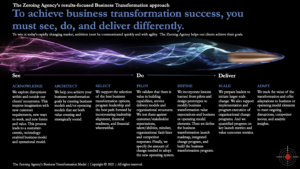The Point: Private Equity-backed businesses outperform their business counterparts in periods of economic uncertainty and/or business transformation because their leaders are more involved in leading. If you’ve read anything about Private Equity or Business Transformation — or Business in general over the last few years, it’s likely that you’ve heard a lot about leaning in. Recently, we’ve encouraged clients to “lean in to business transformation,” or told leaders to “lean in on innovation,” or “detail the future by leaning in.” So we pulled-up recently and asked ourselves at Tip of the Spear Ventures and our Business Transformation Consultancy, The Zeroing Agency, “What’s with all the leaning in going on here?” When business leaders actively accept challenges and seek more responsibility — especially in order to progress towards goal attainment, the “lean in” movement makes sense. And in no other area of business ownership does leaning in on business transformation play out better than with Private Equity. So in this post, we explore Private Equity’s Lean In To Business Transformation… Enjoy!

Attend Webinars & Workshops – View our upcoming Webinars & Workshops
Private Equity’s Business Transformation Performance
It is well-known that the top private equity firms have the highest returns on equity by using financial leverage to improve the strategy and operations and then exiting at higher multiples. PE advocates also argue that strong board governance, management incentives, and a concentrated shareholder pool are essential for long-term success.
Nothing represents business transformation than those industries faced with difficulties, like in oil and gas, as well as mining, in the wake of falling commodity prices. McKinsey conducted a study to determine if more disciplined PE practices would make a difference in difficult economic times. They compared the performance over a period of nine years amongst 659 PE-backed enterprises and public companies in different sectors. They found that PE-backed businesses outperformed public peers in business transformation efforts and those recovering from business distress. This was even after taking into consideration a higher probability of bankruptcy.
Looking to Transform Your Business?
Download Your 37 page | 128 question Business Transformation Self-Assessment Workbook!
Is Private Equity Just Better At Business Transformation?
PE ownership has some advantages over public ownership in business transformation. Based on our experience with both types (full disclosure, Tip of the Spear Ventures is a Private Equity firm), we have found that PE boards are more active in setting ground rules and willing to hold management accountable for a business transformation or turnaround. For example, the most successful PE-backed companies boards quickly change the rules of engagement, communicate performance targets clearly, establish a timetable and determine if the CEO and the leadership team are capable of executing the plans. We have observed that these successful PE boards are also very adept at shifting organizational behavior away from “normal” working mode and into “overdrive” mode when planning progresses to execution.
The Lean Into Rules for Business Transformation
These lean into rules — or requirements — for business transformation are not mandatory for all leaders and their companies boards. Others may not have the time or motivation to follow these guidelines. We believe boards and leaders of public companies can benefit from the urgency, energy, and hands-on involvement in rapid owner-assisted business transformations. PE governance offers clear benefits during difficult times as well as the tangible benefits of active board leadership, and direct owner accountability. These are able to truly transform the game and provide the perfect setting for “lean into” moments for business transformation.
SUMMARY
In this post, we explore Private Equity’s Lean In To Business Transformation. While there is much success provided for PE-backed organizations success during business transformation, it’s important to realize that Private Equity does not own the exclusive rights to business transformation success. The key underlying concepts of urgency, energy, and hands-on involvement regardless of ownership structure are elements of success for those seeking business transformation.
Sam Palazzolo




